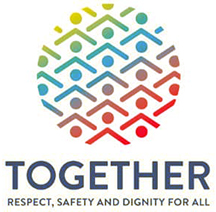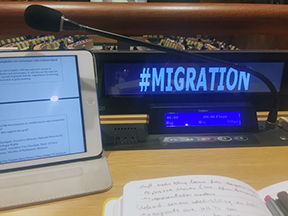Negotiation of Compacts This Year at United Nations
Posted on April 1, 2018, by Loretto Community
By Mary Louise Pabello
Editor’s Note: Mary Louise is a returning Loretto Volunteer now working as NGO U.N. Intern/Loretto Community.

Graphic courtesy of Beth Blissman
The Loretto Community has long supported migrants and refugees in our midst. Here is an update on what has been happening on a global level at the United Nations. In September 2016, the U.N. General Assembly hosted a high-level Summit for Refugees and Migrants. The document resulting from that summit, “The New York Declaration for Refugees and Migrants” (aka “The New York Declaration” or NYD), made history. Not only did all 193 U.N. member states adopt it but it contained bold commitments to addressing the movement of persons in all its facets and an expression of global solidarity in the movement of persons. The NYD charged member states with drafting and ultimately ratifying two separate compacts: a Global Compact for Refugees (GCR), headed by the U.N. Office of the High Commissioner for Refugees, and a Global Compact for Safe, Orderly and Regular Migration (GCM), co-facilitated by the countries of Switzerland and Mexico. I am following the GCM here in New York, as the GCR and its processes take place in Geneva.
After a year’s worth of consultations from member states, civil society and other stakeholders, there was a stocktaking meeting in December 2017. Just two days before the start of stocktaking, U.S. Ambassador Nikki Haley announced that the United States would not participate in the making of this compact, on the grounds of its being “not compatible with U.S. sovereignty.”
Nevertheless, stocktaking continued without U.S. input, and the “Zero-Draft” was published Feb. 5. There are six rounds of negotiations, one week out of every month from February to July 2018. The final draft of the GCM, agreed upon last July, will be formally adopted in December 2018 at the Global Forum on Migration and Development hosted this year by Morocco and Germany.

The Zero-Draft is a well-written, comprehensive document that touches on many different migration flows. It addresses gender concerns acknowledging women and girls are disproportionately vulnerable while migrating and after they’ve reached their destinations; children are vulnerable in ways specific to their age; xenophobia in destination countries; smuggling or trafficking of persons; climate-induced migrants; labor and its potential for migrant exploitation by employers; the use of detention and the criminalization of migrants; and more. Like other U.N. resolutions, this compact and its refugee counterpart have no enforcement power; rather, it is an outline, an ideal of what best practices look like if implemented.
As stated in the NYD, the creation and implementation of both compacts belong to member states. Civil society, the private sector and other non-government stakeholders can only witness these negotiations. What I heard during the first round of negotiations gives cause for concern. A number of member states pressed that the compact differentiate between “regular” and “irregular” migrants, furthermore that the rights of migrants espoused in the Zero-Draft apply only to “regular” migrants. Others insisted that any reference to refugees be removed from the compact as there is a separate compact also in the works meant just for refugees.
These two issues, up for discussion during the second round of negotiations March 12-15, are troubling for many stakeholders. First, the compact’s full title is “Safe, Orderly and Regular Migration.” Nowhere does it suggest that migrant rights belong only to those who travel through legal pathways, nor should it — one’s human dignity is not lessened and cannot be denied because one crosses borders without papers. Furthermore, to regularize migration flows, which is a goal of the GCM, irregular migrants absolutely have to be addressed since they are the ones most in need of regularizing. To say otherwise suggests a willful misunderstanding of their situation.
Insisting on drawing a line between migrants and refugees ignores their complementarity. Refugees are always migrants, but migrants are not always refugees. Refugees have international law protections already in place. What happens to a refugee when he or she no longer meets the qualifications for refugee status? Assuming he or she is not returned to his or her country of origin, he or she could now be classed as a migrant. I will continue to witness the negotiations of the GCM, and Loretto at the UN will advocate for the rights of all migrants and refugees in keeping with Catholic social teaching and Loretto values.
